Home Rehabilitation Products Market Summary, 2031
The global home rehabilitation products market size was at $22.4 billion in 2021, and is projected to reach $43.6 billion by 2031, growing at a CAGR of 7.1% from 2022 to 2031. Home rehabilitation products are used by patients to restore or enhance neurocognitive function that has been lost or impaired. In home care settings, rehabilitation programs assist patients improve, maintain, and recover their physical strength and mobility.
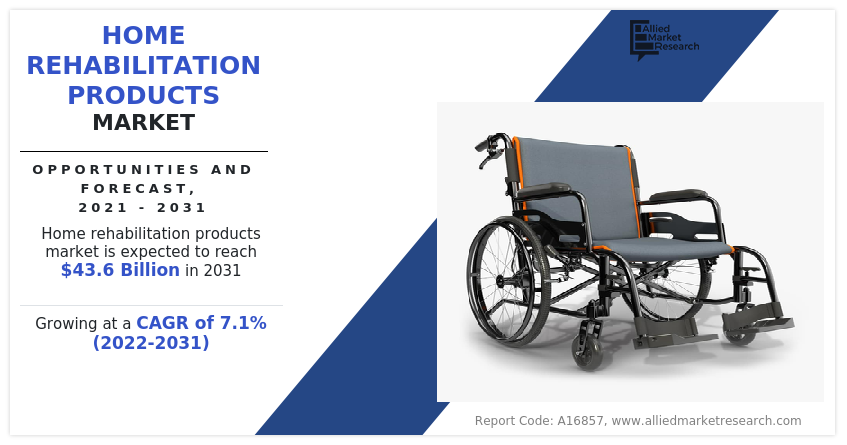
Rehabilitation programs assist persons with impairments by enhancing, preserving, and recovering their physical strength and mobility. Increased elderly population and chronic illness incidence are driving the global market for rehabilitation goods. The global market for home rehabilitation products is extremely disorganized, fragmented, and reasonable.
The home rehabilitation products market is segmented into Product type, Patient type and End user.
During the coronavirus pandemic, home-based rehabilitation has evolved as one of the supporting programs, decreasing the pressure on healthcare workers in hospitals. To keep economies functioning throughout the pandemic, companies in the Home Rehabilitation Products Industry are expanding their supply chains via e-commerce and online pharmacies.
Rise in chronic medical conditions among people throughout the world, which includes high blood pressure and diabetes, along with cardiovascular and respiratory disease that requires regular and continuous monitoring is expected to boost the market growth. Ageing population and changes in societal behavior contribute toward steady increase in these common and costly long-term health problems.
According to the World Health Organization (WHO), chronic diseases, tend to be of long duration and kill around 41 million people each year. Chronic diseases are often associated with older age groups, but as per the WHO more than 15 million of all deaths attributed to chronic diseases occur between the ages of 30 and 69 years. Of these premature deaths, 85% are estimated to occur in low- and middle-income countries.
Children, adults, and the elderly are all vulnerable to risk factors contributing to chronic diseases, whether from unhealthy diets, physical inactivity, and exposure to tobacco smoke or harmful use of alcohol. Thus, rise in chronic conditions across the globe increases home rehabilitation products market demand such as body support devices and mobility assistive devices. Increase in old population throughout the world is one of the key drivers for growth of the home rehabilitation products market.
Presently, most people can expect to live till their sixties and beyond. Every country in the world is experiencing growth in both size and proportion of older persons in the population. According to a study by the WHO, it can be estimated that this shift in distribution of a country's population toward older ages known as population ageing has started in high income countries.
For instance, in Japan 30% of the population is already over 60 years thus spending on home rehabilitation products is expected to increase in Japan. Old age people are more prone to various disorders and disabilities, which ultimately fuels demand for home rehabilitation products across the globe. It was also observed that there are around 382 million old age people aged 60 years and above across the globe and this number is expected to grow by 2.1 billion in the future. This huge rise in old age population is expected to have a positive impact on the rehabilitation product market throughout the world.
The access to rehabilitation services for people with disabilities in low-and middle-income countries (LMICs) such as Kenya, Nigeria, Ghana, and others is limited owing to high cost of rehabilitation products and poor healthcare infrastructure is expected to hamper the market growth. . In addition, availability of doctors and other healthcare staff is very limited in such countries thus restricting the awareness and spread of home rehabilitation products and hampering the market growth. .
As, most of the population in developing country lies under middle class and the lower middle class category it has become difficult for them to adopt such high price rehabilitation products. Moreover, lack of government initiatives to provide subsidy and create awareness regarding home treatment for long term patients has also hampered the market growth.
As the need for rehabilitation has increased, so has advancements of rehabilitation technologies. Home-based advanced technology comprises use of inertial sensors, cell phones, software programs, and commercial gear that are reasonably affordable, user-friendly, and widely accessible and may be used to gather 3D patient motion data and deliver feedback to patients. Application of advanced rehabilitation technology is promising, and its usefulness is widely supported by the available data.
Ultra-lightweight manual wheelchairs are incredibly light, owing to cutting-edge design and engineering techniques and materials such as carbon fiber and aircraft-grade aluminum, and titanium. Power-assist systems give manual wheelchair users a motorized boost to reduce required energy and strength, particularly over longer distances and up ramps or slopes. Thus, recent advancements in material and engineering designs of manual wheelchair are expected to drive the home rehabilitation products market forecast period.
In addition, home rehabilitation products such as medical beds, positioning devices, and exercise products can be completely customized according to customer requirement and daily preferences, which is expected to present good home rehabilitation products market opportunity.
E-commerce or online store is a huge platform growing at a tremendous rate worldwide. Consumers of every age, including generation X, millennial, or generation Z prefer to shop from e-stores. This is attributed to the fact that online shopping is more convenient as compared to shopping at physical stores, owing to rise in number of retailers focusing on e-commerce, thus making it convenient for consumers.
Furthermore, increase in penetration of internet and rise in percentage of population inclining toward online shopping are expected to provide potential opportunities for home rehabilitation product manufacturers to sell their existing as well as novel home rehabilitation products through online platform, thus making them easily available for consumers and increasing consumer awareness about their products.
The global home rehabilitation products market is expected to witness significant growth in countries such as China, Japan, and India. Factors that drive the market growth include increase in number of obese and elderly patients, rise in awareness & expenditure regarding health products, and developments in technology. China has the second-largest obese population in the world, with almost 62 million individuals. Increase in adoption of this equipment in developing economies is expected to create opportunities for Home Rehabilitation Products Industry.
VR-based home rehabilitation can induce successful treatment protocol adherence as effectively as a human-supervised procedure due to real-time multisensory capabilities. Through enhanced stimulation, multisensory, auditory, and visual feedback can motivate consumers to exercise more.
In addition, IVR-based physical rehabilitation permits enhanced quantitative input from both the user and the therapist. VR can also be utilized as a valuable exercise treatment tool for a variety of conditions requiring rehabilitation; it can be a solution to the difficulties associated with traditional exercise therapy approaches.
The global home rehabilitation products market is segmented into type, patient type, end user, distribution channel, and region. On the basis of type, the market is classified into wheelchairs, general aids, body support devices, positioning devices, and others. By patient type, it is categorized into adult and pediatric. Depending on end user, it is bifurcated into hospitals, long term care centers, outpatient centers, medical research institutes, and others. Region wise, the market is analyzed across North America, Europe, Asia-Pacific, and LAMEA.
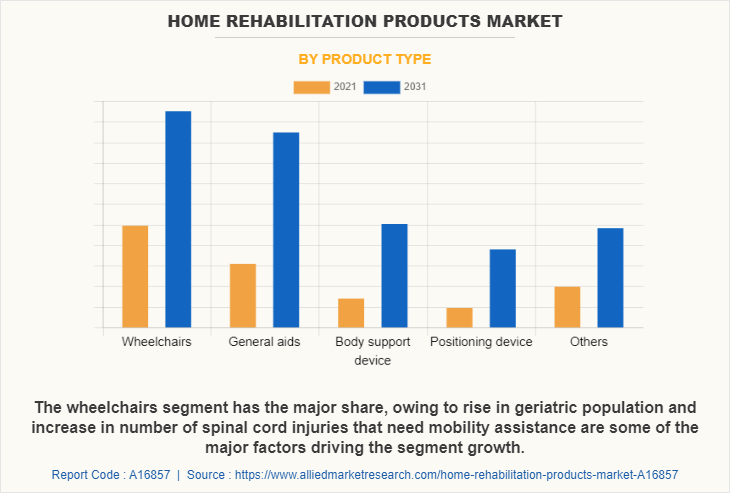
The wheel chair segment dominates the global home rehabilitation products market, owing to rise in geriatric population and increase in number of spinal cord injuries that need mobility assistance are some of the major factors driving the segment growth. The wheelchair market has witnessed a decline in 2020 during the COVID-19 pandemic, owing to disrupted supply chain and operations in different regions.
Moreover, surge in volume of patients suffering from chronic disorder and increase in incidences of disabilities due to road accidents are some of the major as well as vital factors that are expected to augment home rehabilitation products market growth such as wheelchairs.In addition, the presence of various popular brands such as Medline Industries, Inc., Stryker Corporation, Invacare Corporation, DJO Global.
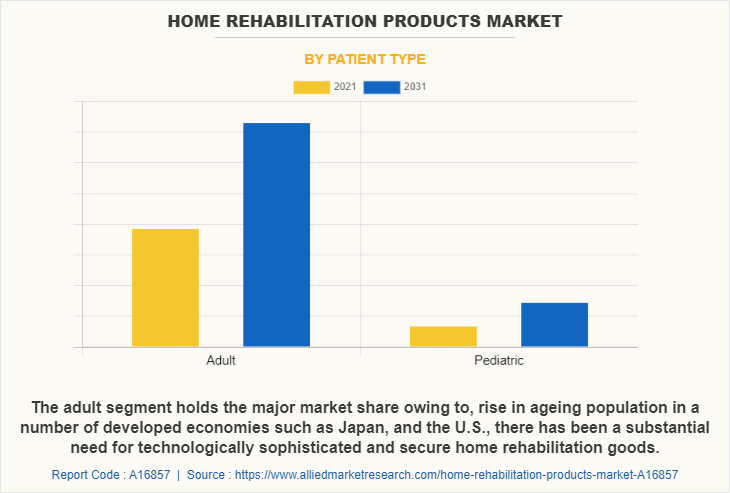
The adult segment exhibits the major home rehabilitation products market share, owing to rise in demand for innovative and advanced rehabilitation facilities improved care and support process, improved patient comfort, combined with aging population, are significant drivers for growth of the global market.
With rise in ageing population in a number of developed economies such as Japan, and the U.S., there has been a substantial need for technologically sophisticated and secure home rehabilitation goods. Growth in chronic and severe diseases, such as cardiovascular diseases and malignancies, also contributes toward increasing demand. Additionally increasing awareness amongst adults for these diseases and disabilities is an important factor in rise of this segment.
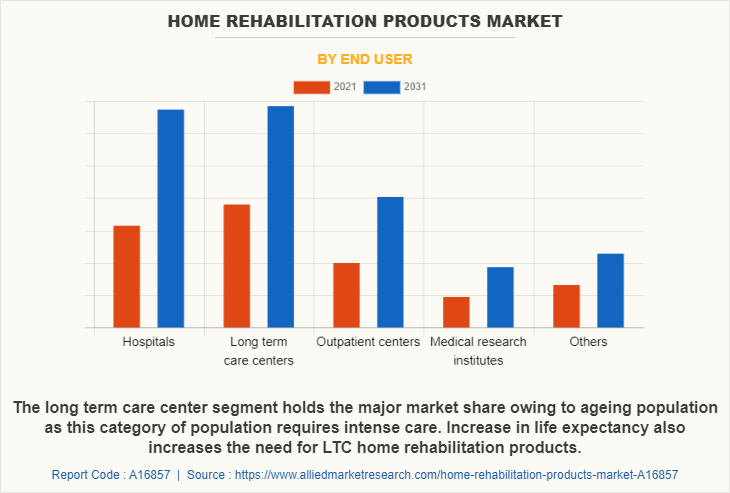
Long-term care centers are the major shareholders in the market. This is attributed to ageing population as this category of population requires intense care. Increase in life expectancy also increases the need for LTC home rehabilitation products.
Provision of personal care at home prevents patients from being hospitalized unnecessarily, saving them money and providing them quality of life, which is expected to contribute toward the market growth. LTC provides specialized care required by elderly and increasing awareness about these centers among consumers as well as their advantages over hospitals is expected to impel the market growth.
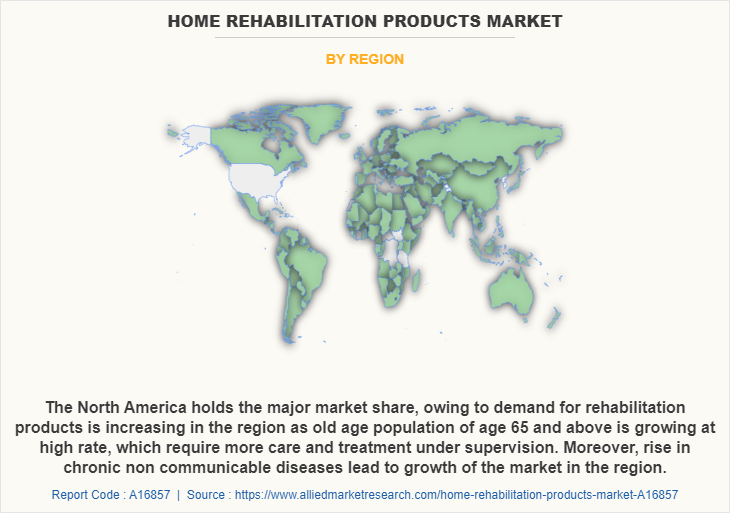
North America was the highest revenue contributor, owing to age population of age 65 and above is growing at high rate, which require more care and treatment under supervision. Moreover, rise in chronic non communicable diseases lead to growth of the market in the region. In addition, growing healthcare infrastructure in Mexico will further boost the home rehabilitation products demand.
Key Benefits For Stakeholders
This report provides a quantitative analysis of the market segments, current trends, estimations, and dynamics of the home rehabilitation products market analysis from 2021 to 2031 to identify the prevailing home rehabilitation products market opportunities.
The market research is offered along with information related to key drivers, restraints, and opportunities.
Porter's five forces analysis highlights the potency of buyers and suppliers to enable stakeholders make profit-oriented business decisions and strengthen their supplier-buyer network.
In-depth analysis of the home rehabilitation products market segmentation assists to determine the prevailing market opportunities.
Major countries in each region are mapped according to their revenue contribution to the global market.
Market player positioning facilitates benchmarking and provides a clear understanding of the present position of the market players.
The report includes the analysis of the regional as well as global home rehabilitation products market trends, key players, market segments, application areas, and market growth strategies.
Home Rehabilitation Products Market Report Highlights
| Aspects | Details |
| Market Size By 2031 | USD 43.6 billion |
| Growth Rate | CAGR of 7.1% |
| Forecast period | 2021 - 2031 |
| Report Pages | 330 |
| By Product type |
|
| By Patient type |
|
| By End user |
|
| By Region |
|
| Key Market Players | Colfax Corp, Drive DeVilbiss International, DJO Global, Performance Health, Arjo, Baxter International, Medline Industries, Inc., Invacare Corporation, RehabCare, Dynatronics Corp., Active Medical and Rehabilitation Services Pvt. Ltd., Handicare Group AB, Stryker Corporation, ergoline GmbH, Ekso Bionics Holdings, Inc. |
Analyst Review
As per insights of industry executives of leading companies, the global home rehabilitation products market is anticipated to witness notable growth during the forecast period. This is attributed to increase in geriatric population, rise in preference for advance products such as automated wheelchairs, and improvement in living standards.
In addition, prominent players in the market have developed and launched innovative technologies, such as electro-magnetic hover technology, artificial intelligence, and heavy-duty home rehabilitation products to cater to a wide customer base in various nations. Automation and automatic operations of wheelchairs are in excessive demand among customers in developing nations. Increase in diseases and disorders such as tetraplegia, impairment, spinal cord injuries, and others, which hamper the ability to walk, majorly drives the market growth. In addition, rise in geriatric patients that are susceptible to walking disabilities, increase in obesity and cardiovascular diseases, and improvement in hospital facility for in-hospital patient treatment drive the home rehabilitation products market. In addition, growth in technological advancements, favorable reimbursement policies, and increment in investments in medicinal services by government and private sectors are projected to fuel the market development in developed and developing countries.
By region, Asia-Pacific possesses high market potential for investments in the home rehabilitation products market, owing to presence of high population base, rise in prevalence of chronic diseases, and increase in healthcare funding by the government. This region is the fastest growing market for home rehabilitation equipment, owing to growth in bariatric & geriatric patients in China, Japan, India, and others.
Rise in chronic medical conditions among consumer, rising geriatric population, rise in trend of home healthcare are some of the upcoming trend in the home rehabilitation market.
The home fragrance market to register at a CAGR of 6.3% from 2019 to 2026.
North America was the largest region for Home rehabilitation products market, whereas Asia-Pacific was the is the fastest growing region during the forecast period.
The home rehabilitation product market size was valued at $22,384.0 million in 2020 and is projected to reach $43,599.3 million by 2031.
The adult segment wasthe highest revenue contributor to the market, owing to rise in demand for innovative and advanced rehabilitation facilities, improved care and support process, and improved patient comfort, combined with an aging population.
Loading Table Of Content...



